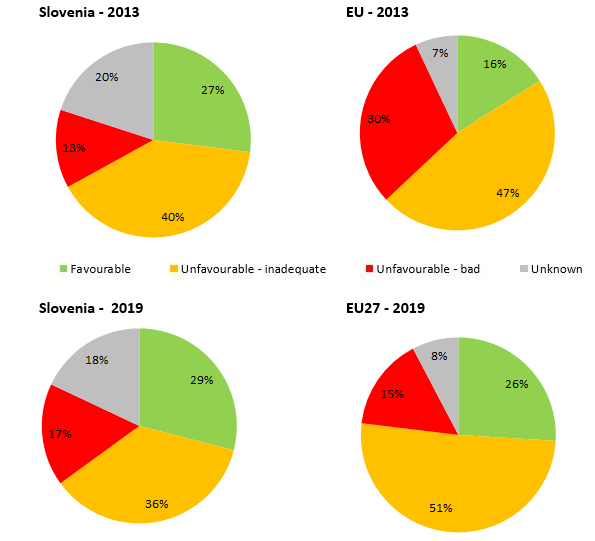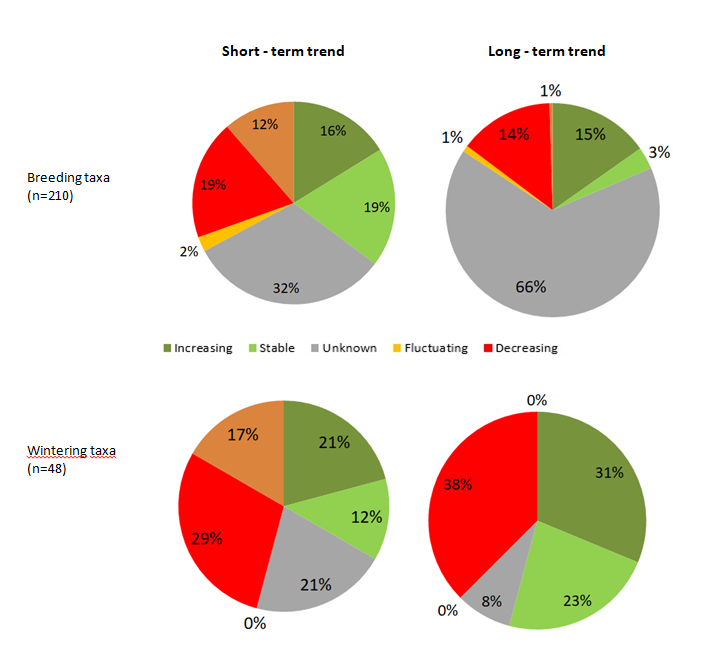[NB11] Species of European interest

Key message

The conservation status of species in Slovenia indicates that only 30% of species have a favorable status. Furthermore, also the trends are unfavourable. In the years 2013-2018, the proportion of species with favorable conservation status remained stable according to the previous reporting period, while the proportion of species with poor conservation status has increased. As many as one third of Europe's important bird species have a negative or uncertain short-term trend. In order to achieve the objectives of the EU Biodiversity Strategy, it is necessary to follow the guidelines of the Regulation on Special Conservation Areas (Natura 2000 sites) more rigorously and to implement the Natura 2000 management program. This is especially important for arthropod species and other species related to aquatic, marshy, marshy and grassland habitats.
Definition
This indicator follows the conservation status of species of European interest. These include the species from the Habitats Directive (Council Directive 92/43/EEC), as listed in Annexes II, IV and V. The indicator is used to assess whether:
- the data on the population dynamics of a certain species indicate that it is capable of maintaining itself on a long-term basis on its own in its natural habitat;
- the natural range of a certain species is not being reduced nor is it likely to be reduced in the future;
- a large enough habitat exists (and will continue to exist) for the long-term conservation of populations of a certain species.
The conservation status of a species is thus used to measure impacts on an individual species, which can have a long-term effect on the size and distribution of its populations.
Charts
Reports under Article 17 on the conservation status of habitats and species under the Habitats Directive for the periods 2004 – 2006, 2007 - 2012 and 2013 - 2018, Ministry of the Environmet and Spatial planning, Institute of the Republic of Slovenia for Nature Conservation, 2020
| Favourable[number] | Unknown[number] | Unfavourable - inadequate[number] | Unfavourable - bad[number] | Favourable[share] | Unknown[share] | Unfavourable - inadequate[share] | Unfavourable - bad[share] | |
|---|---|---|---|---|---|---|---|---|
| 2008 - Alpine | 35 | 33 | 72 | 12 | 23.03 | 21.71 | 47.37 | 7.89 |
| 2013 - Alpine | 44 | 31 | 59 | 13 | 29.93 | 21.09 | 40.14 | 8.84 |
| 2019 - Alpine | 47 | 26 | 42 | 14 | 31 | 17 | 42 | 10 |
| 2008 - Continental | 33 | 35 | 93 | 22 | 18.03 | 19.13 | 50.82 | 12.02 |
| 2013 - Continental | 50 | 34 | 72 | 21 | 28.25 | 19.21 | 40.68 | 11.86 |
| 2019 - Continental | 52 | 33 | 66 | 33 | 28 | 18 | 36 | 18 |
Reports under Article 17 on the conservation status of habitats and species under the Habitats Directive for the periods 2004 – 2006, 2007 - 2012 and 2013 - 2018, Ministry of the Environmet and Spatial planning, Institute of the Republic of Slovenia for Nature Conservation, 2020 (April 202)
| Unknown[number] | Unfavourable - bad[number] | Unfavourable - inadequate[number] | Favourable[number] | |
|---|---|---|---|---|
| 2019 - Mammals 45) | 17.78 | 15.56 | 40 | 26.67 |
| 2013 - Mammals 43) | 37.21 | 11.63 | 27.91 | 23.26 |
| 2008 - Mammals (43) | 46.51 | 2.33 | 20.93 | 30.23 |
| _ | ||||
| 2019 - Reptiles (18) | 16.67 | 0 | 38.89 | 44.44 |
| 2013 - Reptiles (17) | 23.53 | 5.88 | 35.29 | 35.29 |
| 2008 - Reptiles (17) | 5.88 | 29.41 | 52.94 | 11.76 |
| _ | ||||
| 2019 - Amphibians (16) | 12.50 | 25 | 62.50 | 0 |
| 2013 - Amphibians (15) | 13.33 | 6.67 | 80 | 0 |
| 2008 - Amphibians (15) | 13.33 | 0 | 86.67 | 0 |
| _ | ||||
| 2019 - Fish (33) | 24.24 | 18.18 | 21.21 | 36.36 |
| 2013 - Fish (28) | 7.14 | 0 | 53.57 | 39.29 |
| 2008 - Fish (29) | 3.45 | 6.90 | 89.66 | 0 |
| _ | ||||
| 2019 - Anthropods (39) | 15.38 | 28.21 | 43.59 | 12.82 |
| 2013 - Anthropods (43) | 11.63 | 25.58 | 51.16 | 11.63 |
| 2008 - Arthropods (40) | 12.50 | 25 | 50 | 12.50 |
| _ | ||||
| 2019 - Mollusca (11) | 45.45 | 9.09 | 18.18 | 27.27 |
| 2013 - Mollusca (11) | 45.45 | 9.09 | 9.09 | 36.36 |
| 2008 - Mollusca (11) | 36.36 | 9.09 | 36.36 | 18.18 |
| _ | ||||
| 2019 - Vascular plants (35) | 0 | 17.14 | 28.57 | 54.29 |
| 2013 - Vascular plants (33) | 0 | 18.18 | 27.27 | 54.55 |
| 2008 - Vascular plants (39) | 5.13 | 12.82 | 33.33 | 48.72 |
| _ | ||||
| 2019 - Non-vascular plants (6) | 50 | 0 | 50 | 0 |
| 2013 - Non-vascular plants (6) | 50 | 16.67 | 33.33 | 0 |
| 2008 - Non-vascular plants (6) | 50 | 16.67 | 33.33 | 0 |
| _ | ||||
| 2019 - Others (2) | 50 | 0 | 50 | 0 |
| 2013 - Others (2) | 100 | 0 | 0 | 0 |
| 2008 - Others (2) | 0 | 0 | 100 | 0 |
Reports under Article 17 on the conservation status of habitats and species under the Habitats Directive for the period 2013 - 2018, Ministry of the Environmet and Spatial planning, Institute of the Republic of Slovenia for Nature Conservation, 2020
| Future threats | Actual pressures | |
|---|---|---|
| A - Agriculture | 23.26 | 27.50 |
| B - Forestry | 11.17 | 9.75 |
| C - Extraction of resources | 2.14 | 1.77 |
| D - Energy production processes | 1.53 | 1.38 |
| E - Transport systems | 3.21 | 3.38 |
| F - Residential, commercial, industrial and recreational infrastructure and areas | 18.82 | 18.13 |
| G - Extraction and cultivation of biological living resources | 6.66 | 6.45 |
| H - Military action and public safety measures | 0.31 | 0.38 |
| I - Alien and problematic species | 4.82 | 2.00 |
| J - Pollution | 2.83 | 3.30 |
| K - Human-induced changes in water regimes | 14.08 | 14.90 |
| L - Natural processes | 3.75 | 3.30 |
| M - Geological events, natural catastrophes | 0.77 | 0.54 |
| N - Climate change | 3.14 | 2.53 |
| X - Unknown pressures / no pressures | 3.52 | 4.69 |
Reports under Article 17 on the conservation status of habitats and species under the Habitats Directive for the periods 2004 – 2006, 2007 - 2012 and 2013 - 2018, Ministry of the Environmet and Spatial planning, Institute of the Republic of Slovenia for Nature Conservation, 2020
| Slovenia-2008[%] | EU25-2008[%] | Slovenia 2013[%] | EU - 27 2013[%] | Slovenia 2019[%] | EU - 27 2019[%] | |||
|---|---|---|---|---|---|---|---|---|
| Favourable | 20 | 17 | 27 | 16 | 29 | 27 | ||
| Unfavourable - inadequate | 49 | 30 | 40 | 47 | 36 | 53 | ||
| Unfavourable - bad | 12 | 22 | 13 | 30 | 17 | 16 | ||
| Unknown | 19 | 31 | 20 | 7 | 18 | 8 |
Reports under Article 12 on the conservation status of birds under the Bird Directive for the period 2013 - 2018, Ministry of the Environmet and Spatial planning, Institute of the Republic of Slovenia for Nature Conservation, 2020
| Increasing[share] | Stable[share] | Unknown[share] | Fluctuating[share] | Decreasing[share] | Uncertain[share] | Increasing[number] | Stable[number] | Unknown[number] | Fluctuating[number] | Decreasing[number] | Uncertain[number] | |
|---|---|---|---|---|---|---|---|---|---|---|---|---|
| Short-term trend 2008 - 2018 | 16.61 | 16.97 | 30.63 | 1.85 | 21.40 | 12.55 | 45 | 46 | 83 | 5 | 58 | 34 |
| Long-term trend 1980 - 2018 | 18.08 | 6.64 | 56.46 | 0.74 | 17.71 | 0.37 | 49 | 18 | 153 | 2 | 48 | 1 |
Reports under Article 12 on the conservation status of birds under the Bird Directive for the period 2013 - 2018, Ministry of the Environmet and Spatial planning, Institute of the Republic of Slovenia for Nature Conservation, 2020
| Increasing[share] | Stable[share] | Unknown[share] | Fluctuating[share] | Decreasing[share] | Uncertain[share] | |
|---|---|---|---|---|---|---|
| Breeding taxa - short-term trend | 34 | 40 | 67 | 5 | 40 | 24 |
| Breeding taxa - long-term trend | 32 | 7 | 138 | 2 | 30 | 1 |
| Wintering taxa - short-term trend | 10 | 6 | 10 | 0 | 14 | 8 |
| Wintering taxa - long-term trend | 15 | 11 | 4 | 0 | 18 | 0 |
Goals
- To maintain a favourable status of all autochthonous animal and plant species (Strategy – SI);
- To halt the deterioration of the status of all species covered by EU nature protection legislation and to achieve a significant and measurable improvement of their status so that by 2020, 50% or more species assessments conducted in accordance with the Habitats Directive have reached a favourable conservation status or shown a significant improvement in their status compared to the present assessments. (Strategy – EU)










